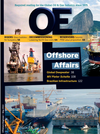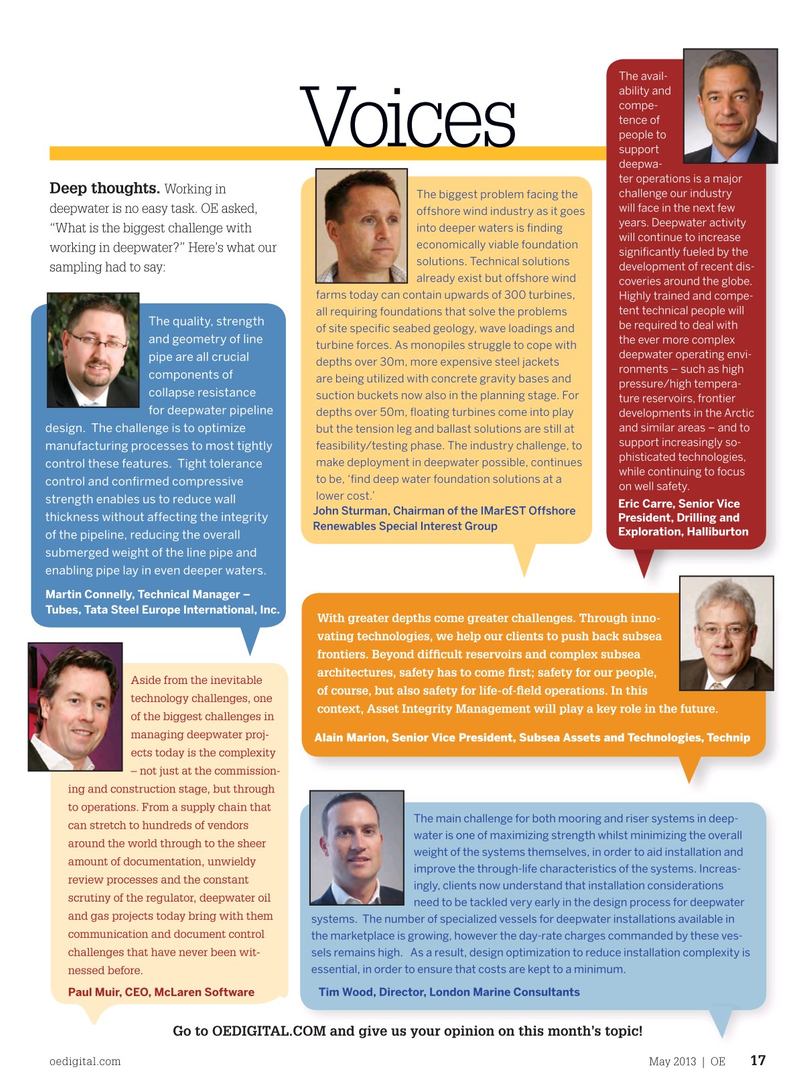
Page 15: of Offshore Engineer Magazine (May/Jun 2013)
Read this page in Pdf, Flash or Html5 edition of May/Jun 2013 Offshore Engineer Magazine
The avail- ability and compe- tence of people to Voices support deepwa- ter operations is a major
Deep thoughts. Working in challenge our industry
The biggest problem facing the will face in the next few deepwater is no easy task. OE asked, offshore wind industry as it goes years. Deepwater activity into deeper waters is fnding “What is the biggest challenge with will continue to increase economically viable foundation working in deepwater?” Here’s what our signifcantly fueled by the solutions. Technical solutions development of recent dis- sampling had to say: already exist but offshore wind coveries around the globe. farms today can contain upwards of 300 turbines, Highly trained and compe- tent technical people will all requiring foundations that solve the problems
The quality, strength be required to deal with of site specifc seabed geology, wave loadings and and geometry of line the ever more complex turbine forces. As monopiles struggle to cope with deepwater operating envi- pipe are all crucial depths over 30m, more expensive steel jackets ronments – such as high components of are being utilized with concrete gravity bases and pressure/high tempera- collapse resistance suction buckets now also in the planning stage. For ture reservoirs, frontier for deepwater pipeline depths over 50m, foating turbines come into play developments in the Arctic and similar areas – and to design. The challenge is to optimize but the tension leg and ballast solutions are still at support increasingly so- feasibility/testing phase. The industry challenge, to manufacturing processes to most tightly phisticated technologies, make deployment in deepwater possible, continues control these features. Tight tolerance while continuing to focus to be, ‘fnd deep water foundation solutions at a control and confrmed compressive on well safety.
lower cost.’ strength enables us to reduce wall
Eric Carre, Senior Vice
John Sturman, Chairman of the IMarEST Offshore thickness without affecting the integrity
President, Drilling and
Renewables Special Interest Group
Exploration, Halliburton of the pipeline, reducing the overall submerged weight of the line pipe and enabling pipe lay in even deeper waters.
Martin Connelly, Technical Manager –
Tubes, Tata Steel Europe International, Inc.
With greater depths come greater challenges. Through inno- vating technologies, we help our clients to push back subsea frontiers. Beyond diffcult reservoirs and complex subsea architectures, safety has to come frst; safety for our people,
Aside from the inevitable of course, but also safety for life-of-feld operations. In this technology challenges, one context, Asset Integrity Management will play a key role in the future.
of the biggest challenges in managing deepwater proj-
Alain Marion, Senior Vice President, Subsea Assets and Technologies, Technip ects today is the complexity – not just at the commission- ing and construction stage, but through to operations. From a supply chain that
The main challenge for both mooring and riser systems in deep- can stretch to hundreds of vendors water is one of maximizing strength whilst minimizing the overall around the world through to the sheer weight of the systems themselves, in order to aid installation and amount of documentation, unwieldy improve the through-life characteristics of the systems. Increas- review processes and the constant ingly, clients now understand that installation considerations scrutiny of the regulator, deepwater oil need to be tackled very early in the design process for deepwater and gas projects today bring with them systems. The number of specialized vessels for deepwater installations available in communication and document control the marketplace is growing, however the day-rate charges commanded by these ves- challenges that have never been wit- sels remains high. As a result, design optimization to reduce installation complexity is essential, in order to ensure that costs are kept to a minimum.
nessed before.
Paul Muir, CEO, McLaren Software Tim Wood, Director, London Marine Consultants
Go to OEDIGITAL.COM and give us your opinion on this month’s topic!
oedigital.com May 2013 | OE 17 05oe_voices.indd 17 4/22/13 3:35 PM

 14
14

 16
16